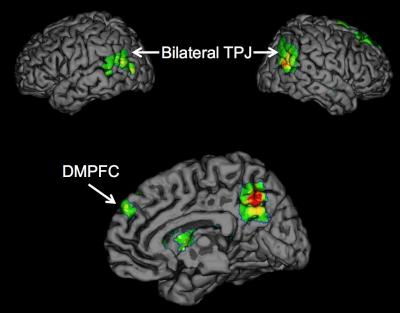
How do ideas spread? Why do some videos go viral? UCLA scientists have taken a first step toward answering these questions by identifying the brain regions associated with the successful spread of ideas.
The research, reported in the journalPsychological Science, has broad implications and could lead to more persuasive advertisements and better ways for teachers to communicate with students. The study suggests that people are regularly attuned to how the things they’re seeing will be useful and interesting. “Not just to themselves, but to other people,” explained the study’s senior author, Matthew Lieberman. “We always seem to be on the lookout for who else will find this helpful, amusing or interesting.”
In the first part of the study, subjects underwent fMRI brain scans as they saw and heard information about 24 potential television pilot ideas. Among the fictitious pilots were a show about former beauty-queen mothers who want their daughters to follow in their footsteps; a Spanish soap opera about a young woman and her relationships; a reality show in which contestants travel to countries with harsh environments; a program about teenage vampires and werewolves; and a show about best friends and rivals in a crime family.
The subjects exposed to these TV pilot ideas were asked to envision themselves as television studio interns who would decide whether or not they would recommend each idea to their “producers.” These students made videotaped assessments of each pilot.
Another group of subjects were asked to act as the “producers.” These students watched the interns’ videos assessments of the pilots and then made their own ratings about the pilot ideas based on those assessments.
The researchers then focused on which brain regions were activated when the interns were first exposed to information they would later pass on to others.
“We’re constantly being exposed to information on Facebook, Twitter and so on,” said Lieberman. “Some of it we pass on, and a lot of it we don’t. Is there something that happens in the moment we first see it – maybe before we even realize we might pass it on – that is different for those things that we will pass on successfully versus those that we won’t?”
The researchers found that the interns who were especially good at persuading the producers showed significantly more activation in a brain region known as the temporoparietal junction (TPJ), at the time they were first exposed to the pilot ideas they would later recommend. Lieberman said they had more activation in this region than the interns who were less persuasive and more activation than they themselves had when exposed to pilot ideas they didn’t like. “It was the only region in the brain that showed this effect,” Lieberman noted. “One might have thought brain regions associated with memory would show more activation, but that was not the case.”

The TPJ, located on the outer surface of the brain, is part of what is known as the brain’s mentalizing network, which is involved in assessing about what other people think and feel. The network also includes the dorsomedial prefrontal cortex (DMPFC), located in the middle of the brain.
“When we read fiction or watch a movie, we’re entering the minds of the characters – that’s mentalizing,” Lieberman explained. “As soon as you hear a good joke, you think, ‘Who can I tell this to and who can’t I tell?’ Making this judgment will activate these two brain regions. Good ideas turn on the mentalizing system. They make us want to tell other people.”
The study notes that the interns who showed more activity in their mentalizing system when they saw the pilots they intended to recommend were then more successful in convincing the producers to also recommend those pilots.
Lieberman and Falk suggest that by further studying the neural activity in these brain regions, researchers could potentially predict which advertisements are most likely to spread and go viral and which will be most effective.
“Before this study, we didn’t know what brain regions were associated with ideas that become contagious, and we didn’t know what regions were associated with being an effective communicator of ideas,” said Falk. “Now we have mapped the brain regions associated with ideas that are likely to be contagious and are associated with being a good ‘idea salesperson.’ In the future, we would like to be able to use these brain maps to forecast what ideas are likely to be successful and who is likely to be effective at spreading them.”
Related:
Discuss this article in our forum
MRI scans predict pop music success
This is your brain on iTunes
Are close friends on Facebook the enemy?
Addicted To Knowledge









Comments are closed.